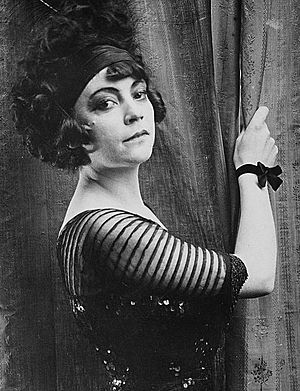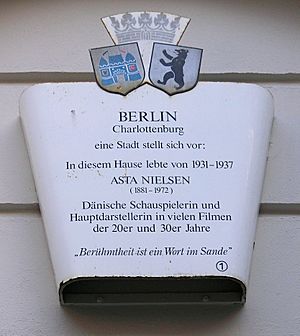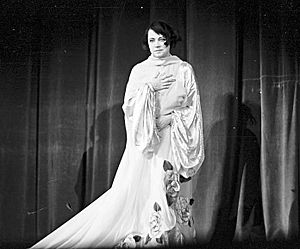Asta Nielsen facts for kids
Quick facts for kids
Asta Nielsen
|
|
|---|---|

Asta Nielsen in 1911
|
|
| Born |
Asta Sofie Amalie Nielsen
11 September 1881 Vesterbro, Denmark
|
| Died | 24 May 1972 (aged 90) Frederiksberg, Denmark
|
| Burial place | Vestre Cemetery, Copenhagen, Denmark |
| Nationality | Danish |
| Alma mater | Royal Danish Theatre |
| Occupation | Actor |
| Years active | 1902–1936 |
| Spouse(s) |
|
| Partner(s) | Gregori Chmara (1923–1936) |
| Children | 1 |
Asta Sofie Amalie Nielsen (born September 11, 1881 – died May 24, 1972) was a Danish actress. She was famous for her roles in silent films. In the 1910s, she became one of the first international movie stars. Most of her 74 films were made in Germany. There, people simply called her Die Asta, which means The Asta.
Asta Nielsen was known for her big dark eyes and serious face. She often played strong women who faced sad situations. She helped change acting in movies from being overly dramatic to a more natural style.
In the 1920s, Nielsen started her own film studio in Berlin. But she moved back to Denmark in 1937 because of the rise of Nazism in Germany. Later in life, she became a collage artist and wrote books.
Contents
Early life
Asta Sofie Amalie Nielsen was born in Vesterbro, a part of Copenhagen, Denmark. Her father, Jens Christian Nielsen, was a blacksmith who often didn't have work. Her mother, Ida Frederikke Petersen, was a washerwoman. Asta had an older sister, Johanne, who was often sick.
Asta's family moved many times when she was a child. They lived in Malmö, Sweden, for a few years. Her father worked in a mill and a factory there. After he lost those jobs, they moved back to Copenhagen. Asta's father died when she was 14 years old.
When Asta was 18, she was accepted into the acting school of the Royal Danish Theatre. She studied with a famous actor named Peter Jerndorff. In 1901, Asta had a daughter named Jesta. Asta raised Jesta by herself, with help from her mother and sister. Jesta passed away in 1964.
Asta finished theater school in 1902. For the next three years, she worked at the Dagmar Theatre. Then she toured Norway and Sweden from 1905 to 1907. She returned to Denmark and worked at Det Ny Theater until 1910. Even though she acted a lot on stage, her performances were not very special. People said her unique look was great for movies, but her voice was not good for the stage.
Film career
Asta Nielsen started her movie career in 1909. Her first big role was in the 1910 film Afgrunden ("The Abyss"), directed by Urban Gad. In this film, Asta showed her simple acting style. She played a young woman who gets into a sad situation. The film was a big success. Because of this, Asta decided to keep acting in movies instead of on stage.
Asta and Urban Gad got married. They made four more films together. Asta's popularity grew very fast. This led them to move from Denmark to Germany. In Germany, she got her own film studio and could earn more money.
In Germany, Asta signed a contract with producer Paul Davidson. They started a company called Internationale Film-Vertriebs-Gesellschaft. This company owned the rights to all of Asta's films in Europe. Asta became a huge international movie star, known as "Die Asta." In 1914 alone, she earned a very high salary.
Asta Nielsen was one of the highest-paid film stars of her time. Many people consider her the first international movie star. In 1911, a poll in Russia voted her the world's top female movie star. She remained popular during World War I. In 1915, she visited New York City to learn about American film techniques.
In 1921, Asta Nielsen started her own film company, Asta Films. She starred in Hamlet, directed by Svend Gade and Heinz Schall. This movie was a new way of looking at William Shakespeare's play. Asta played Hamlet as a woman who dressed up as a man.
In 1925, she acted in the German film Die freudlose Gasse (The Joyless Street). This film also starred Greta Garbo, who became a big Hollywood star later.
Asta worked in German films until movies started having sound. She made only one sound film, Unmögliche Liebe (Crown of Thorns) in 1932. However, the new sound technology didn't suit her acting style. Also, she was older, and young American actresses were becoming popular. So, she stopped making movies. After that, Asta only acted on stage.
After the rise of Nazism in Germany, propaganda minister Joseph Goebbels offered Asta her own studio. Asta later said she had tea with Adolf Hitler. He tried to convince her to return to films, explaining how powerful her presence was on screen. Asta understood what this meant and refused. She left Germany in 1936. She went back to Denmark, where she wrote articles about art and politics, and a two-book autobiography.
Asta Nielsen is seen as a great movie actress. This is because of her natural acting style. She changed her acting to fit movies, avoiding overly dramatic stage acting. She was also good at playing women from different social backgrounds and with different personalities.
Assistance to Jews during World War II
During World War II, Asta Nielsen helped a young Dane named Allan O. Hagedorff. He was living in Germany and helped Jewish people. Asta gave him money. Hagedorff used this money to send many food packages to the Theresienstadt Ghetto. The German secret police, the Gestapo, even warned him because he sent so many. He also offered money to others, like the writer Victor Klemperer.
Relationships and death
Asta Nielsen had four long-term relationships and was divorced twice. In 1912, she married Danish film director Urban Gad. They had moved to Germany together in 1911. They divorced in 1919.
Then, Asta married Swedish shipbuilder Freddy Windgårdh in 1919. This marriage ended in divorce in 1923. Asta then fell in love with the Russian actor Gregori Chmara. They lived together from 1923 until 1936.
In the late 1960s, Asta started a relationship with Danish art collector Christian Theede. She had met him through her own artwork. In 1970, when Asta was 88 years old, she married 77-year-old Christian Theede. Their marriage at an older age was celebrated around the world. Asta Nielsen died on May 25, 1972, at the age of 90, in Frederiksberg Hospital.
Legacy

The Belgian writer Paul van Ostaijen wrote a poem called "Asta Nielsen" in 1921. It was a tribute to her beauty and charm.
Joachim Ringelnatz, a poet who often visited Asta's home, also wrote poems about her. These included "About Asta Nielsen" in 1928 and "Asta Nielsen Dedicates a Trophy" in 1929.
Filmography
- 1910: Afgrunden (The Abyss) (short)
- 1911: Gipsy Blood (short, missing)
- 1911: The Moth (missing)
- 1911: Den sorte drøm (eng. The Black Dream)
- 1911: Im großen Augenblick (short) (eng. At the Big Moment)
- 1911: Balletdanserinden (eng. Ballet Dancers)
- 1911: Der fremde Vogel (eng. The Alien Bird)
- 1911: The Traitress (fragments preserved)
- 1912: Die Macht des Goldes (missing) (eng. The Power of Gold)
- 1912: Zu Tode gehetzt (missing) (eng. Rushing to Death)
- 1912: Poor Jenny (short)
- 1912: The Dance of Death (short, fragment)
- 1912: Die Kinder des Generals (missing) (eng. The General's Children)
- 1912: Wenn die Maske fällt (fragments preserved) (eng. When the Mask is Gone)
- 1912: Das Mädchen ohne Vaterland (short) (eng. The Girl without a Homeland)
- 1912: Jugend und Tollheit (short, missing) (eng. Youth and Craziness)
- 1913: Komödianten (short, missing) (eng. Comedians)
- 1913: Die Sünden der Väter (eng. The Sins of the Fathers)
- 1913: Der Tod in Sevilla (short) (eng. Death in Sevilla)
- 1913: Die Suffragette (fragments preserved) (eng. The Suffragette)
- 1913: Die Filmprimadonna (short, fragments preserved) (eng. The Prima Donna of Film)
- 1914: Little Angel
- 1914: Das Kind ruft (eng. The Child Calls)
- 1914: Zapata's Gang (short)
- 1914: Das Feuer (eng. The Fire)
- 1915: Fräulein Feldwebel (short) (eng. Miss Sergeant)
- 1915: Die Tochter der Landstraße (eng. The Daughter of the Country Road)
- 1915: The False Asta Nielsen
- 1916: Die ewige Nacht (eng. Eternal Night)
- 1916: Engeleins Hochzeit (missing) (eng. Little Angel's Wedding)
- 1916: Frontstairs and Backstairs
- 1916: Dora Brandes
- 1916: The ABC of Love
- 1916: Cinderella (missing)
- 1916: Das Versuchskaninchen (short) (eng. The Guinea Pig)
- 1917: The White Roses (produced 1914–1915)
- 1917: Die Brüder (eng. The Brothers)
- 1917: Das Waisenhauskind (eng. The Child of the Orphanage)
- 1918: Im Lebenswirbel (produced 1916) (eng. Inside the Fuss of Life)
- 1918: Rose of the Wilderness (produced 1916)
- 1918: The Eskimo Baby (produced 1916)
- 1918: The Queen of the Stock Exchange (produced 1916)
- 1919: So Ends My Song
- 1919: Towards the Light
- 1919: According to Law
- 1920: The Merry-Go-Round
- 1920: Helmsman Holk
- 1920: Kurfürstendamm (eng. Prince Elector Embankment; Note: "Kurfürstendamm" is the name of a famous street in Berlin, Germany.)
- 1921: Hamlet: The Drama of Vengeance
- 1921: Roswolsky's Mistress
- 1921: Wandering Souls
- 1922: Miss Julie
- 1922: Brigantenrache (eng. Brigand's Revenge)
- 1922: Vanina
- 1922: Navarro the Dancer
- 1923: Earth Spirit
- 1923: Downfall
- 1923: I.N.R.I.
- 1924: The House by the Sea
- 1924: Joyless Street
- 1924: The Woman in Flames
- 1924: Athletes
- 1925: Hedda Gabler
- 1925: Living Buddhas (produced 1923–1924)
- 1925: Joyless Street
- 1926: The Fallen
- 1927: Laster der Menschheit (eng. Mankind's Vices)
- 1927: Tragedy of the Street
- 1927: Agitated Women
- 1927: Small Town Sinners
- 1927: That Dangerous Age
- 1932: Impossible Love
Images for kids
See also
 In Spanish: Asta Nielsen para niños
In Spanish: Asta Nielsen para niños




